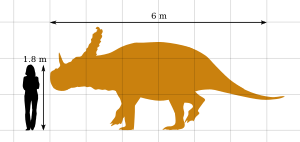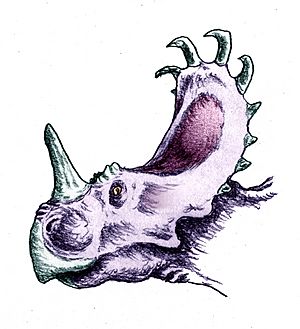Sinoceratops facts for kids
Quick facts for kids Sinoceratops |
|
|---|---|
 |
|
| Scientific classification | |
| Kingdom: | |
| Phylum: | |
| Class: | |
| Superorder: | |
| Order: | |
| Infraorder: | |
| Family: | |
| Subfamily: |
Centrosaurinae
|
| Genus: |
Sinoceratops
Xu et al., 2010
|
Sinoceratops was a type of dinosaur that lived about 73 million years ago. This amazing creature roamed the Earth during the late Cretaceous Period. Its fossils were found in Shandong province in China.
Scientists named Sinoceratops in 2010. The name Sinoceratops zhuchengensis means "Chinese horned face from Zhucheng." Zhucheng is the place in China where its bones were discovered.
This dinosaur was a medium-sized herbivore, meaning it ate plants. It walked on four legs, like a rhinoceros. Sinoceratops could grow up to 6 meters (about 20 feet) long and 2 meters (about 6.5 feet) tall. It weighed as much as 2 tons, which is like two small cars!
Sinoceratops was the first horned dinosaur found in China. It's also the only one of its kind, called a centrosaurine, known from Asia. Most other horned dinosaurs like it lived in North America. Sinoceratops was also one of the biggest centrosaurines ever found.
This dinosaur lived in an area called the Xingezhuang Formation. This place was full of life during the late Cretaceous Period. Sinoceratops shared its home with other dinosaurs. These included plant-eaters like Shantungosaurus and Zhuchengceratops. It also lived near huge meat-eaters like Zhuchengtyrannus.
What Did Sinoceratops Look Like?
Sinoceratops was a large horned dinosaur. It was about 6 meters (20 feet) long and 2 meters (6.5 feet) tall. It weighed around 2 tons. Some scientists, like Thomas R. Holtz Jr., thought it might have been even bigger, up to 7 meters (23 feet) long and 2.3 tons. That's about the weight of a large rhinoceros.
This dinosaur had a short, curved horn on its nose. But it didn't have any horns above its eyes. Its most striking feature was its short neck frill. This frill had a row of horn-like bumps that curved forward, making it look like a crown. Inside these bumps, there were smaller knobs on top of the frill. These knobs are unique to Sinoceratops and aren't seen in other horned dinosaurs.
Scientists study the skull of Sinoceratops to learn more about it. The skull of one Sinoceratops was about 180 centimeters (6 feet) long. This makes it one of the largest skulls found for a centrosaurine dinosaur.
Unique Features of Sinoceratops
Every dinosaur has special features that make it different from others. For Sinoceratops, scientists have found a few key things that set it apart:
- It had at least ten strong, curved horn-like bumps along the back edge of its frill.
- It also had at least four horn-like bumps on the sides of its frill.
- Unlike most other centrosaurines, Sinoceratops had an extra opening in its skull near its nose.
- The edge of its frill was not very wavy, which is also different from other centrosaurines.
- It had wide, flat bumps on its frill called epoccipitals. These were also unique compared to other centrosaurines.
These special features help scientists identify Sinoceratops fossils and understand how it relates to other dinosaurs.
Images for kids





